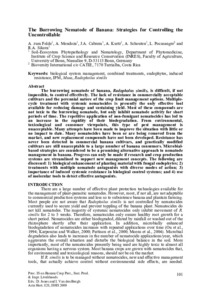| dc.contributor.author | Felde, A. zum |
| dc.contributor.author | Mendoza, A. |
| dc.contributor.author | Cabrera, J.A. |
| dc.contributor.author | Kurtz, A. |
| dc.contributor.author | Schouten,A. |
| dc.contributor.author | Pocasangre, L. |
| dc.contributor.author | Sikora, R.A. |
| dc.date.accessioned | 2019-12-04T11:11:42Z |
| dc.date.available | 2019-12-04T11:11:42Z |
| dc.date.issued | 2009 |
| dc.identifier.citation | zum Felde,A., Mendoza, A., Cabrera, J.A., Kurtz, A., Schouten,A., Pocasangre, L. & Sikora, R.A. (2009). The burrowing nematode of banana: Strategies for controlling the uncontrollable. Acta Horticulturae, 828, 101-107. |
| dc.identifier.issn | 0567-7572 |
| dc.identifier.uri | https://hdl.handle.net/20.500.12478/2482 |
| dc.description.abstract | The burrowing nematode of banana, Radopholus similis, is difficult, if not impossible, to control effectively. The lack of resistance in commercially acceptable cultivars and the perennial nature of the crop limit management options. Multiple-cycle treatment with systemic nematocides is presently the only effective tool available for reducing damage and sustaining yield. Most of these compounds are not toxic to the burrowing nematode, but only inhibit nematode activity for short periods of time. The repetitive application of non-fumigant nematocides has led to an increase in the rapidity of their biodegradation. From environmental, toxicological and consumer viewpoints, this type of pest management is unacceptable. Many attempts have been made to improve the situation with little or no impact to date. Many nematocides have been or are being removed from the market, and new replacement compounds have not been developed. Resistance has never been detected in commercial banana cultivars, and genetically modified cultivars are still unacceptable to a large number of banana consumers. Microbial-based strategies are considered to be a promising alternative approach to nematode management in banana. Progress can only be made if research and crop production systems are streamlined to support new management concepts. The following are discussed: 1) biological enhancement of planting material with fungal endophytes; 2) treatments with multiple nematode antagonists with diverse modes of action; 3) importance of induced systemic resistance in biological control systems; and 4) use of molecular tools to detect effective antagonists. |
| dc.format.extent | 101-107 |
| dc.language.iso | en |
| dc.subject | Biological System Management |
| dc.subject | Combined Treatments |
| dc.subject | Endophytes |
| dc.subject | Induced Resistance |
| dc.subject | Ipm |
| dc.subject | Musa |
| dc.subject | Radopholus Similis |
| dc.title | The burrowing nematode of banana: strategies for controlling the uncontrollable |
| dc.type | Journal Article |
| dc.description.version | Peer Review |
| cg.contributor.affiliation | International Institute of Tropical Agriculture |
| cg.contributor.affiliation | University of Bonn |
| cg.contributor.affiliation | Bioversity International |
| cg.coverage.region | Acp |
| cg.coverage.region | North America |
| cg.coverage.region | Central America |
| cg.coverage.country | Guatemala |
| cg.authorship.types | CGIAR and advanced research institute |
| cg.iitasubject | Plant Diseases |
| cg.iitasubject | Disease Control |
| cg.iitasubject | Pests Of Plants |
| cg.iitasubject | Genetic Improvement |
| cg.iitasubject | Plantain |
| cg.journal | Acta Horticulturae |
| cg.howpublished | Formally Published |
| cg.accessibilitystatus | Limited Access |
| local.dspaceid | 93233 |
| cg.identifier.doi | https://dx.doi.org/10.17660/ActaHortic.2009.828.9 |

